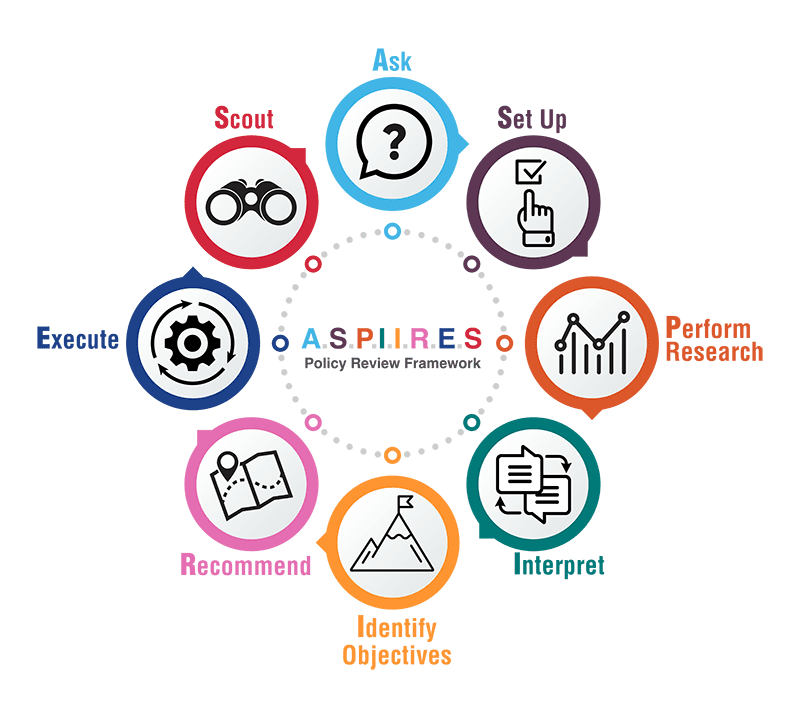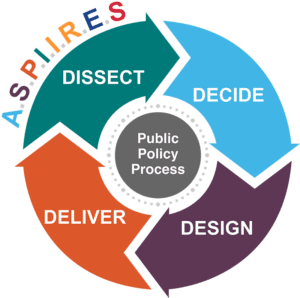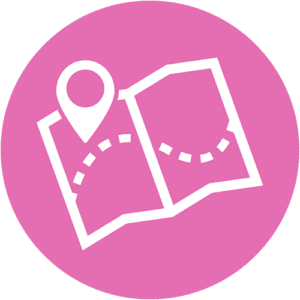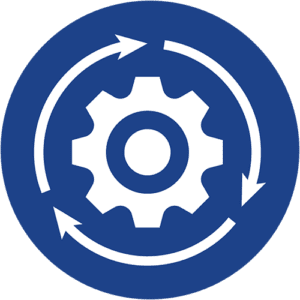
Every state wants its residents to be able to compete in the 21st-century economy. That’s why several state leaders have set big goals for boosting the share of the population with college degrees and other credentials — making higher education and training more accessible, flexible, and affordable. But how well, and for whom, are those policies working?
Ed Trust teamed up with Lumina Foundation and a handful of states to design a way for state officials to assess how they’re doing. The result is the A.S.P.I.I.R.E.S framework for higher education state policy review.
A.S.P.I.I.R.E.S is a tool state leaders can use to evaluate progress toward their public policy goals and chart the best course forward. Scroll down to see how it works and sign up below to learn more.*
Read about the importance of more and better data in addressing postsecondary education inequities on Data Quality Campaign’s blog.


ASK
This first step is simple but important. Here’s a model to start with: How well is policy (x) working for population (y) with respect to policy goal (z)? Even if the focus population is “all residents” or “all students,” ensure a commitment to identify any disparities that may exist by race/ethnicity, income, or other relevant attributes.
Kentucky has a goal to have 60% of the working-age population holding a postsecondary degree or credential by 2030. To that end, Kentucky ASPIIRES to provide students with the resources they need for success. Given the positive correlation between basic needs security – food, housing, a rainy day fund, etc. – college completion, and high levels of poverty, state officials in the Kentucky Student Success Collaborative, an arm of the KY Council on Postsecondary Education, asked how well Kentucky is meeting the basic needs of college students in the state, including students of color, students with Pell Grants, and students age 25 and older.
SET UP
Assign personnel, create teams to conduct the project, and provide any needed training. Ensure all are on the same page about the goals and approach. Set a budget and secure funding. Define the project scope, including the project timeline, the look-back period, and the regions or colleges to include. Identify key performance indicators (KPIs) used to judge desired outcomes. Decide which data sources to use and which stakeholders to engage. Establish systems for managing the project and keeping everyone informed.

The Kentucky Student Success Collaborative created a core team within the agency and expanded the project team by partnering with three faculty researchers, setting up the KY Basic Needs Action Network comprising dozens of statewide stakeholders, and securing participation from the Kentucky Center for Statistics (KYSTATS). They focused, in part, on college student access to two federal benefits programs – Temporary Assistance for Needy Families (TANF) and Supplemental Nutrition Assistance Program (SNAP) – and various campus-based resources. They budgeted funds to compensate participating colleges and to hire a consultant with knowledge of benefits access nationally and in other states. The core team also identified a set of principles to guide the overall project:
- Centering student voice
- Involving diverse project teams
- Ensuring cultural competency
- Disaggregating data by race, region, and income

PERFORM RESEARCH
This is the digging process. See what the numbers say, and disaggregate data by race/ethnicity, income, and other attributes. Hear what the stakeholders say, and involve students whenever possible. Compare policies and programs against what’s permitted and what’s proven. Keep everything organized. Prepare summary slides for non-technical stakeholders to understand results.
Kentucky used multiple approaches to paint a picture of basic needs access among college students. These included:
- A longitudinal, inter-agency data project, in partnership with the Kentucky Center for Statistics (KYSTATS)
- Campus-based research on student basic needs availability, awareness, and access, in partnership with three faculty researchers at three Kentucky universities
- A public benefits policy scan and interviews with diverse statewide stakeholders
INTERPRET
Now that you’ve gathered all relevant information, go back to the key question(s) and the KPIs you set. What’s working well, what’s falling short, and why? How might policies and programs be improved to expand opportunity and improve outcomes? Answers to these questions are your project findings. If you end up with more questions than answers, consider going back to the SET UP phase and revise the approach, but be mindful of timelines, as students need support now.

Using the number of students with Pell Grants as a proxy for the number of students who might be eligible for federal food assistance, Kentucky found a substantial “SNAP Gap” at the state’s public colleges. In other words, large numbers of students from low-income backgrounds who are likely eligible for the federal Supplemental Nutrition Assistance Program were not receiving it. It turned out that students had limited information and assistance, and it appeared across racial groups and college campuses. Kentucky also learned they were not maximizing policy opportunities to include college students in SNAP according to federal rules, and that the basic needs services advertised on college websites don’t always match the services available to students. Kentucky involved the statewide KY Student Basic Needs Action Network in reviewing and interpreting the research information to arrive at these findings.

IDENTIFY OBJECTIVES
Once you’ve interpreted the information and assembled findings, it’s time to identify objectives. If you found that policies and programs are falling short, what would improvement look like in one year, three years, five years? Have a destination in mind before figuring out how to get there. If the research identifies any disparities among students or state residents by race/ethnicity, income, or other attributes, ensure there are objectives to address these disparities.
Kentucky identified two main objectives based on their findings:
- Increase access to basic needs supports for college students
- Increase access to postsecondary education for Kentuckians receiving state supports
While child care was not a dominant policy focus at the outset of the project, it emerged from the research as an important “basic need” for current and prospective students. For example, one member of the Student Basic Needs Action Network said, “If we don’t figure out child care, we’ll never meet our higher ed goals.”
Similarly, the second objective, creating smoother onramps to education and training for people receiving public assistance, was not part of the initial project plan. It emerged through conversations as a shared interest among education and human services stakeholders.
RECOMMEND
Now that you have set objectives, develop the roadmap for reaching them. Design recommendations and secure commitments to change policies, adjust policy implementation, and improve programs. While legislative change may be on the list, focus on opportunities within the purview of state agencies, postsecondary training providers, and statewide partners who can hit the ground running.

Kentucky state officials and stakeholders co-developed numerous recommendations aimed at meeting the two project objectives that emerged from the research. Some recommendations included:
• Implement basic needs screening and benefits eligibility screening for students
• Review state public benefit plans and programs to increase flexibility for postsecondary students
• Increase staff capacity of colleges and universities to provide basic needs support to students
• Explore models and incentives to increase direct referrals from human services and workforce agencies to postsecondary education and training programs

EXECUTE
Simply put, it’s now time to put the plan in motion. Identify roles, implementation plans, and timelines for advancing each recommendation or commitment. Communicate and collaborate with relevant stakeholders to increase support, reduce opposition, and accelerate progress.
Kentucky secured an early win. Soon after higher education staff presented basic needs policy review findings and recommendations to senior officials in the state, human services officials committed to placing full-time “kynectors” – Kentucky public employees responsible for increasing awareness and uptake of public benefits programs – on public college and university campuses at no cost to the colleges.
In addition, Kentucky developed a set of “critical success factors” to guide the execution of their remaining plans for increasing access to basic needs among students and for increasing access to postsecondary education and training among Kentuckians receiving state support. These factors included:
• Commitment: Ensure institutional and organizational leadership awareness, engagement, and commitment to support the common objectives to increase prosperity and economic mobility of Kentuckians
• Infrastructure: Establish the infrastructure for the Student Basic Needs Action Network and a Guiding Team to sustain partnerships, scale strategies, and accelerate progress and success toward achieving the common objectives
• Asset mapping: Develop a comprehensive and exhaustive asset map of statewide partners, programs, capacity, and resources to maximize the collective assets for the benefit of Kentuckians
• Communication: Create a communications plan and messaging campaign to advance the common objectives including communications expectations, timelines, protocols, and digital assets for all partners
• Data systems: Leverage the longitudinal data system and partnerships to track inputs, impact, and outcomes of efforts to increase postsecondary completion and economic mobility of Kentuckians
The Kentucky Student Success Collaborative prepared philanthropic funding proposals to support their continued work, and they set up a community of practice for sharing recommendations and identifying campus engagement opportunities for carrying them out.
SCOUT
Track and tweak to make sure your policy is at its peak. If you’re hitting roadblocks, what adjustments are needed and who can help? Monitor outcomes for different groups of students to ensure your changes are reducing inequality, not exacerbating it. Go back to an earlier part of the A.S.P.I.I.R.E.S framework if you need to.

Kentucky state higher education officials did not end the project by producing a report. They are working closely with the KY Student Basic Needs Action Network, institutions of higher education, and the Kentucky Center for Statistics to implement recommendations and monitor outcomes.
At Ed Trust, we will keep learning with supporting public officials who are working to improve opportunity and outcomes in higher education, especially for students of color and students from low-income backgrounds. The A.S.P.I.I.R.E.S framework is one tool for doing that. Read our Frequently Asked Questions blog post.
*The Ed Trust A.S.P.I.I.R.E.S framework uses examples from the Kentucky Student Success Collaborative. We are deeply grateful to officials in Colorado, Hawaii, Kentucky, Louisiana, and Massachusetts for their collaboration on this project. As we continue to learn from officials in these and other states, we will publish accompanying stories, tools, and resources inspired by their work.
